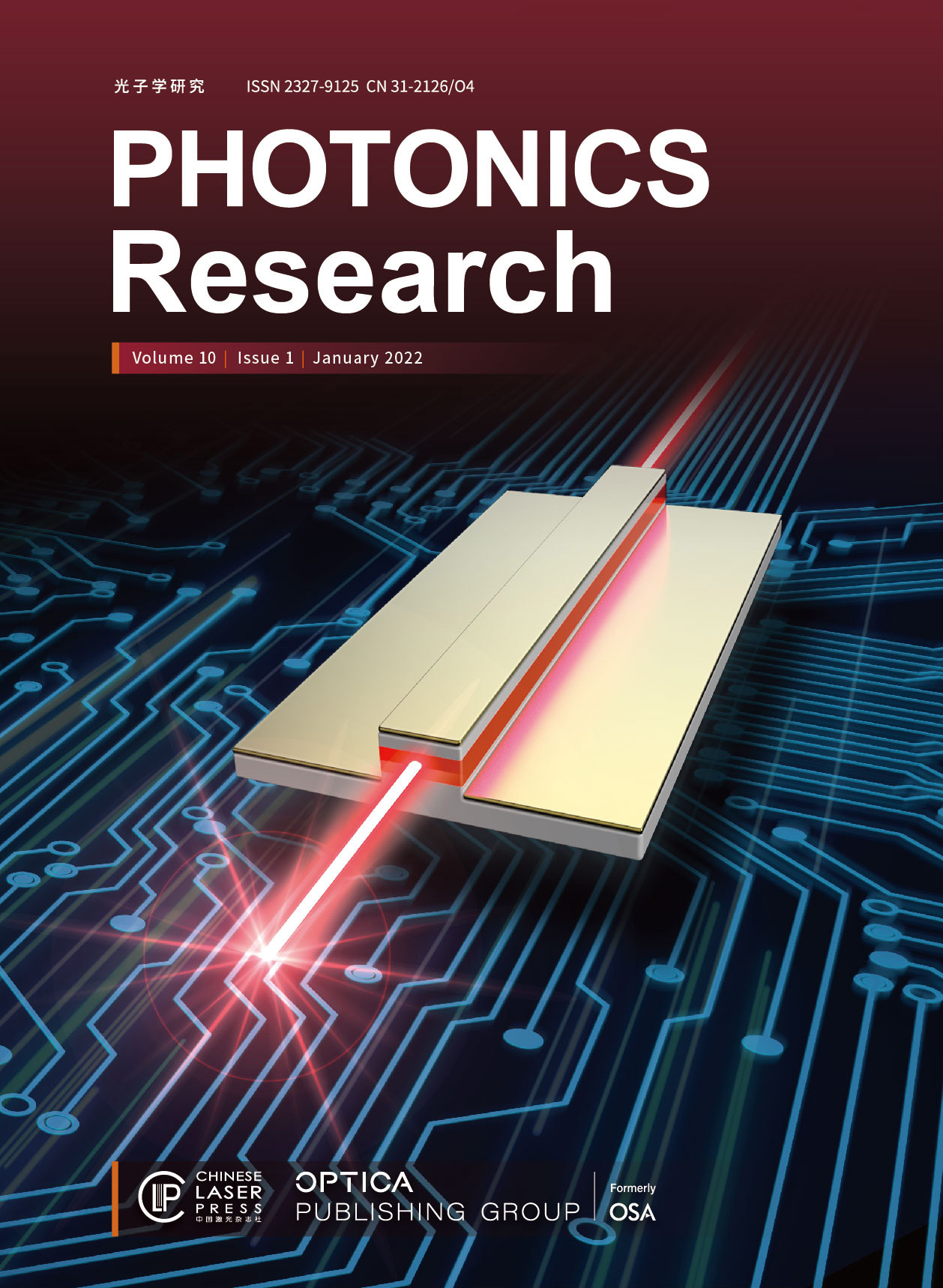Convergence of high-performance silicon photonics and electronics, monolithically integrated in state-of-the-art CMOS platforms, is the holy grail for enabling the ultimate efficiencies, performance, and scaling of electronic-photonic systems-on-chip. It requires the emergence of platforms that combine state-of-the-art RF transistors with optimized silicon photonics, and a generation of photonic device technology with ultralow energies, increased operating spectrum, and the elimination of power-hungry thermal tuning. In this paper, in a co-optimized monolithic electronics-photonics platform (GlobalFoundries 45CLO), we turn the metal-oxide-semiconductor (MOS) field-effect transistor’s basic structure into a novel, highly efficient MOS capacitor ring modulator. It has the smallest ring cavity (1.5 μm radius), largest corresponding spur-free free spectral range (
- Publication Date: Dec. 22, 2021
- Vol. 10, Issue 1, A1 (2022)
The polarization beam splitter is a key component for polarization manipulation in photonic integrated circuits, but it is challenging to design for low-refractive-index optical materials, due to the low birefringence of the waveguides. We propose what we believe is a novel compact vertical-dual-slot waveguide-based coupling scheme for silicon carbide, enabling efficient low-birefringence polarization splitting by extensively modulating the transverse-magnetic mode distribution. We numerically and experimentally demonstrate the device in the 4H-silicon-carbide-on-insulator integrated platform, with a small footprint of
- Publication Date: Dec. 22, 2021
- Vol. 10, Issue 1, A8 (2022)
- Publication Date: Dec. 21, 2021
- Vol. 10, Issue 1, 205 (2022)
- Publication Date: Dec. 09, 2021
- Vol. 10, Issue 1, 21 (2022)
- Publication Date: Dec. 13, 2021
- Vol. 10, Issue 1, 104 (2022)
- Publication Date: Dec. 16, 2021
- Vol. 10, Issue 1, 120 (2022)
- Publication Date: Dec. 21, 2021
- Vol. 10, Issue 1, 189 (2022)
- Publication Date: Dec. 22, 2021
- Vol. 10, Issue 1, 237 (2022)
- Publication Date: Dec. 13, 2021
- Vol. 10, Issue 1, 59 (2022)
- Publication Date: Dec. 09, 2021
- Vol. 10, Issue 1, 1 (2022)
- Publication Date: Dec. 09, 2021
- Vol. 10, Issue 1, 8 (2022)
- Publication Date: Dec. 13, 2021
- Vol. 10, Issue 1, 76 (2022)
- Publication Date: Dec. 21, 2021
- Vol. 10, Issue 1, 214 (2022)
- Publication Date: Dec. 24, 2021
- Vol. 10, Issue 1, 261 (2022)
- Publication Date: Dec. 22, 2021
- Vol. 10, Issue 1, 256 (2022)
- Publication Date: Dec. 09, 2021
- Vol. 10, Issue 1, 14 (2022)
- Publication Date: Dec. 09, 2021
- Vol. 10, Issue 1, 41 (2022)
- Publication Date: Dec. 13, 2021
- Vol. 10, Issue 1, 68 (2022)
- Publication Date: Dec. 21, 2021
- Vol. 10, Issue 1, 197 (2022)
- Publication Date: Dec. 13, 2021
- Vol. 10, Issue 1, 50 (2022)
- Publication Date: Dec. 16, 2021
- Vol. 10, Issue 1, 148 (2022)
- Publication Date: Dec. 21, 2021
- Vol. 10, Issue 1, 183 (2022)
- Publication Date: Dec. 22, 2021
- Vol. 10, Issue 1, 230 (2022)
- Publication Date: Dec. 13, 2021
- Vol. 10, Issue 1, 111 (2022)
- Publication Date: Dec. 16, 2021
- Vol. 10, Issue 1, 155 (2022)
- Publication Date: Dec. 09, 2021
- Vol. 10, Issue 1, 33 (2022)
- Publication Date: Dec. 21, 2021
- Vol. 10, Issue 1, 174 (2022)
- Publication Date: Dec. 21, 2021
- Vol. 10, Issue 1, 222 (2022)
- Publication Date: Dec. 22, 2021
- Vol. 10, Issue 1, 248 (2022)
- Publication Date: Dec. 13, 2021
- Vol. 10, Issue 1, 84 (2022)
Optical fiber surface plasmon resonance (SPR) sensors point toward promising application potential in the fields of biomarker detection, food allergen screening, and environmental monitoring due to their unique advantages. This review outlines approaches in improving the fiber SPR sensing performance, e.g., sensitivity, detection accuracy, reliability, cross-sensitivity, selectivity, convenience and efficiency, and corresponding sensing applications. The sensing principles of SPR sensors, especially the performance indicators and their influencing factors, have been introduced. Current technologies for improving the fiber SPR performance and their application scenarios are then reviewed from the aspects of fiber substrate, intrinsic layer (metal layer), and surface nanomaterial modification. Reasonable design of the substrate can strengthen the evanescent electromagnetic field and realize the multi-parameter sensing, and can introduce the in situ sensing self-compensation, which allows corrections for errors induced by temperature fluctuation, non-specific binding, and external disturbances. The change of the intrinsic layer can adjust the column number, the penetration depth, and the propagation distance of surface plasmon polaritons. This can thereby promote the capability of sensors to detect the large-size analytes and can reduce the full width at half-maximum of SPR curves. The modification of various-dimensionality nanomaterials on the sensor surfaces can heighten the overlap integral of the electromagnetic field intensity in the analyte region and can strengthen interactions between plasmons and excitons as well as interactions between analyte molecules and metal surfaces. Moreover, future directions of fiber SPR sensors are prospected based on the important and challenging problems in the development of fiber SPR sensors.
.- Publication Date: Dec. 16, 2021
- Vol. 10, Issue 1, 126 (2022)
- Publication Date: Dec. 16, 2021
- Vol. 10, Issue 1, 166 (2022)
- Publication Date: Dec. 13, 2021
- Vol. 10, Issue 1, 96 (2022)
About the Cover
The GeSn double heterostructure laser diode generates the laser beam. With the GeSn active region, this laser is composited by the all-group-IV semiconductor and alloy (namely Si, Ge, GeSn, and SiGeSn), enabling the monolithic integration of lasers on the Si platform.














